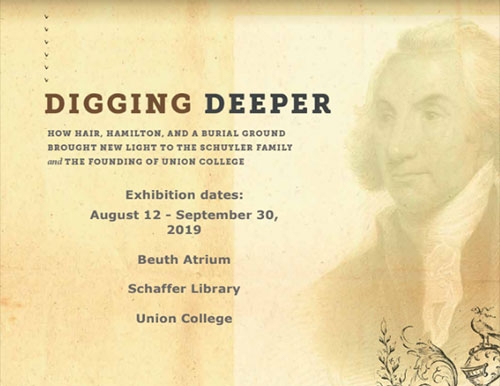In February 2018, the College found itself in the middle of a media maelstrom when it announced the discovery of a rare lock of George Washington’s hair tucked inside an envelope in a long-forgotten book in Schaffer Library.
The 1793 book belonged to Philip J. Schuyler, son of Gen. Philip Schuyler, considered among the College’s founders. The eldest Schuyler was also a close friend of Washington, served under him during the Revolutionary War and later became a U.S. senator from Albany.
More than 2,500 print and broadcast media outlets reported on the historic find. The New York Times ran a story on its front page on President’s Day with the headline: “Finding a Lock of George Washington’s Hair, and a Link to American History.”
While attention focused on the hair, the discovery also offered a window into the Schuyler family and its role in the founding of Union in 1795.
That backstory is the focus of a new exhibit, “Digging Deeper: How Hair, Hamilton, and a Burial Ground Brought New Light on the Schuyler Family and the Founding of Union College.” The exhibit opens Monday, Aug. 12, in the library’s Beuth Atrium and runs through Sept. 30.
The exhibit’s opening coincides with the two-week run of the smash hit musical “Hamilton” at Proctors in downtown Schenectady. The 16 performances will bring tens of thousands of people in close proximity to campus.
“We are exploring how Washington's hair triggered a different view on the founding of Union College,” said India Spartz, co-curator of the exhibit and former head of Special Collections and Archives.
As a member of the New York State Board of Regents, General Schuyler supported the placement of a college in Schenectady instead of Albany. The exhibit includes his letter announcing the granting of a charter for Union and other letters about the Schuyler family.
Using research by co-curator Andrew Cassarino ’18, the exhibit also traces the profound connections between Union’s early founders and slaveholders, including the Schuylers.
“Like most affluent landowners at the time, the Schuyler family reaped great personal wealth from slave labor,” Spartz said. “Andy highlights his own research into the Schuyler family connection to slavery and recent archaeological discoveries at the Schuyler Flatts Burial Ground.”
In 2005, the remains of 14 presumed slaves were uncovered just outside of Albany on the site of a former farm owned by the Schuyler family. In 2016, the remains were reburied. The project, overseen by the New York State Museum, also included facial reconstructions of the slaves.
The exhibit features photos of the reconstructed faces.
Also on display, of course, will be the hair and related items. After the media frenzy died down, the material was professionally conserved. It is kept in a secure, climate-controlled area in Special Collections.
“The discovery of Washington’s hair expanded our understanding of Union’s own historical narrative,” Spartz said. “What better time to share that story than while ‘Hamilton’ is in town?”
The Schuyler connection to Alexander Hamilton is through the founding father's marriage to Elizabeth "Eliza" Schuyler.
Hamilton has strong ties to the College.
When Hamilton, 49, was mortally wounded in a famous pistol duel with U.S. vice president Aaron Burr in July 1804, the Albany Common Council invited 31-year-old Eliphalet Nott, a Presbyterian pastor and gifted orator, to give the local eulogy. Hamilton was a parishioner of Nott’s and the two men were friends.
Nott’s anti-dueling sermon garnered national attention and a month later, he assumed the presidency of Union, a position he would hold for a record 62 years.
In 1875, the grandson of Hamilton gifted an elegant oil painting of his prominent grandfather to the College. The portrait is currently on loan to the Albany Institute of History & Art.
Schuyler’s portrait is also on loan to the Albany Institute; it typically hangs in Hale House dining hall. It was presented to the College by his great grandson, Robert Livingston Schuyler, at Union’s first Founders Day on Feb. 27, 1937.
